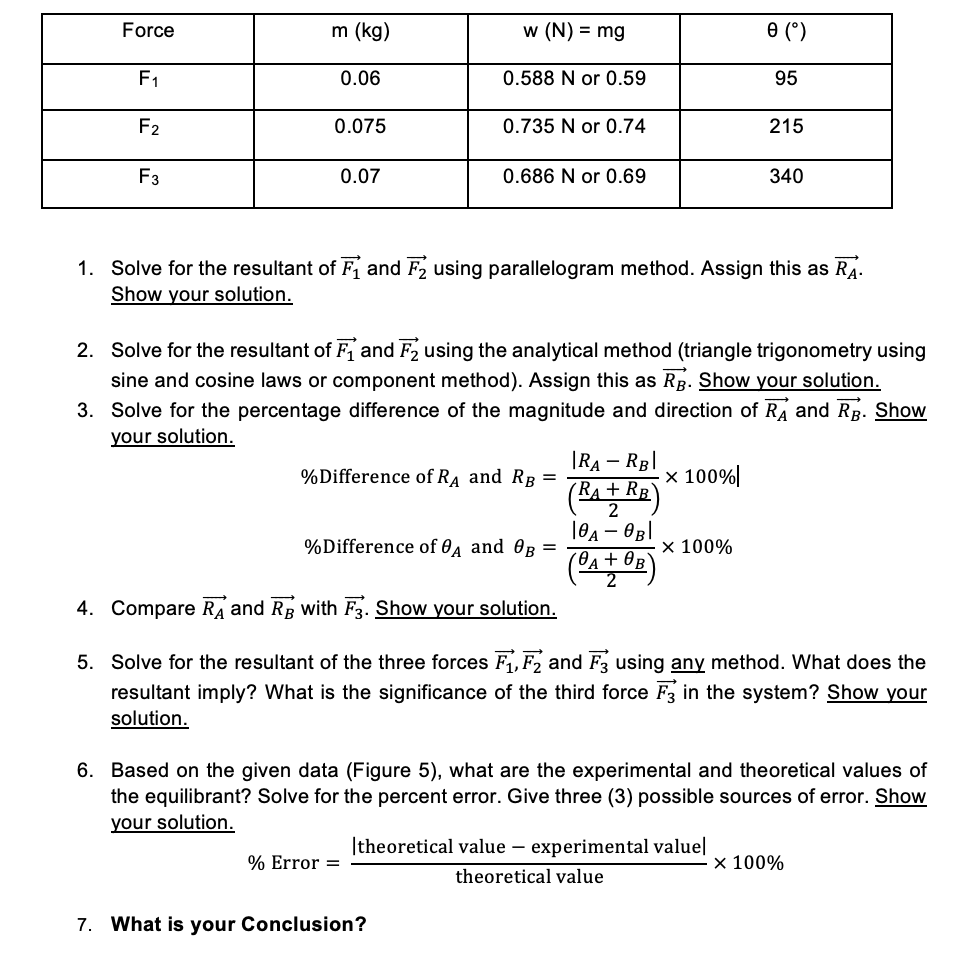1. Solve for the resultant of F and F2 using parallelogram method. Assign this as RA. Show your solution. 2. Solve for the resultant of F and F2 using the analytical method (triangle trigonometry using sine and cosine laws or component method). Assign this as RB. Show your solution. 3. Solve for the percentage difference of the magnitude and direction of RA and Rg. Show your solution. |RA – RB| (RA+ RB - %Difference of RA and RB = × 100%| %Difference of OA and OB x 100% = Oa + 0B 2 Compore D ond D with Sho w vouur solution
1. Solve for the resultant of F and F2 using parallelogram method. Assign this as RA. Show your solution. 2. Solve for the resultant of F and F2 using the analytical method (triangle trigonometry using sine and cosine laws or component method). Assign this as RB. Show your solution. 3. Solve for the percentage difference of the magnitude and direction of RA and Rg. Show your solution. |RA – RB| (RA+ RB - %Difference of RA and RB = × 100%| %Difference of OA and OB x 100% = Oa + 0B 2 Compore D ond D with Sho w vouur solution
Physics for Scientists and Engineers, Technology Update (No access codes included)
9th Edition
ISBN:9781305116399
Author:Raymond A. Serway, John W. Jewett
Publisher:Raymond A. Serway, John W. Jewett
Chapter11: Angular Momentum
Section: Chapter Questions
Problem 11.4OQ: Let the four compass directions north, east, south, and west be represented by unit vectors ne . ....
Related questions
Question

Transcribed Image Text:Force
m (kg)
w (N) = mg
e (°)
F1
0.06
0.588 N or 0.59
95
F2
0.075
0.735 N or 0.74
215
F3
0.07
0.686 N or 0.69
340
1. Solve for the resultant of F and F2 using parallelogram method. Assign this as RA.
Show your solution.
2. Solve for the resultant of F and F2 using the analytical method (triangle trigonometry using
sine and cosine laws or component method). Assign this as RB. Show your solution.
3. Solve for the percentage difference of the magnitude and direction of RA and RB. Show
your solution.
- Rg|
%Difference of RA and RB =
× 100%|
(RA + RB
2
%Difference of 0A and OB =
x 100%
OA + 0B
4. Compare RA and Rg with F3. Show your solution.
5. Solve for the resultant of the three forces F, F2 and F3 using any method. What does the
resultant imply? What is the significance of the third force F3 in the system? Show your
solution.
6. Based on the given data (Figure 5), what are the experimental and theoretical values of
the equilibrant? Solve for the percent error. Give three (3) possible sources of error. Show
your solution.
|theoretical value – experimental value|
% Error =
х 100%
theoretical value
7. What is your Conclusion?
Expert Solution
This question has been solved!
Explore an expertly crafted, step-by-step solution for a thorough understanding of key concepts.
Step by step
Solved in 2 steps with 2 images

Knowledge Booster
Learn more about
Need a deep-dive on the concept behind this application? Look no further. Learn more about this topic, physics and related others by exploring similar questions and additional content below.Recommended textbooks for you

Physics for Scientists and Engineers, Technology …
Physics
ISBN:
9781305116399
Author:
Raymond A. Serway, John W. Jewett
Publisher:
Cengage Learning

Physics for Scientists and Engineers, Technology …
Physics
ISBN:
9781305116399
Author:
Raymond A. Serway, John W. Jewett
Publisher:
Cengage Learning